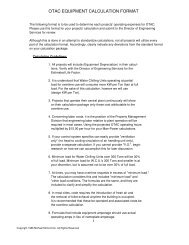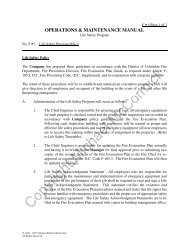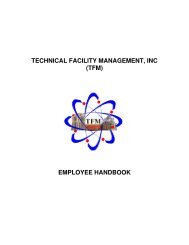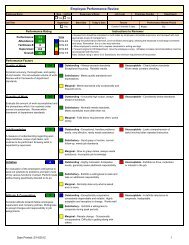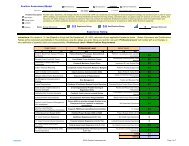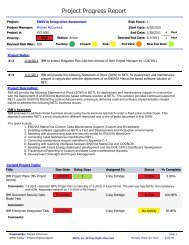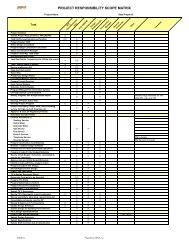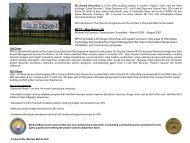OPERATIONS & MAINTENANCE MANUAL - McCormick PCS Info
OPERATIONS & MAINTENANCE MANUAL - McCormick PCS Info
OPERATIONS & MAINTENANCE MANUAL - McCormick PCS Info
You also want an ePaper? Increase the reach of your titles
YUMPU automatically turns print PDFs into web optimized ePapers that Google loves.
<strong>MAINTENANCE</strong> MANAGEMENT<strong>OPERATIONS</strong> & <strong>MAINTENANCE</strong> <strong>MANUAL</strong>C • 6/Page 4 of 5No. C • 6Outside AirInspect the system on a regular basis. Take a look at coils, drain pans, ductwork, andsimilar areas for mold, mildew, standing water, and other biological contaminants. Be sureto change filters in an air-filtering system to prevent dust and biological contaminants intothe air.• Increasing the Volume of Fresh AirAn inadequate supply of fresh outside air can also cause problems. A poorly designedsystem may be unable to supply enough fresh air. Or an adequate system may be operatedat a low volume or velocity. This lack of proper ventilation may allow many chemicals tobuild up to the point where no single chemical reaches unsafe levels, yet the sum createsdiscomfort, lethargy, and low employee productivity.In many cases, you can correct indoor air problems by increasing the outside airflow intoyour facility. To determine how much fresh air you need, you should look to the AmericanSociety of Heating, Refrigerating and Air Conditioning Engineers (ASHRAE). Thisindustry association publishes advisory standards known as voluntary consensus standards.These standards are designed to improve “comfort” and to avoid any adverse health effects.IAQ GuidelinesASHRAE defines good indoor air quality as “air in which there are no known contaminants atharmful concentrations and with which a substantial majority (80 percent) of people exposed donot express dissatisfaction.”In 1989, ASHRAE drastically revised its 1981 standards, which had called for a minimum of 5cubic feet per minute of outdoor air per person (5 cfm/person) in nonsmoking areas. Today, theorganization recommends a minimum of 15 cfm/person, and it suggests even greater volumes offresh air depending on the work environment.A key piece of evidence that persuaded the society to make the change was a four-year study ofacute respiratory diseases among thousands of U.S. Army recruits. Soldiers housed in modern,energy-efficient barracks caught the flu far more often than those living in older, unsealed barracks.ASHRAE’s updated ventilation standard (consensus number 62-1989) is known as Ventilation forAcceptable Indoor Air Quality. This voluntary standard recommends the following ventilationrates:• At least 15 cubic feet per minute of outdoor air per person (15 cfm/person).© 1992 - 1997, Michael Robert <strong>McCormick</strong>All Rights Reserved




